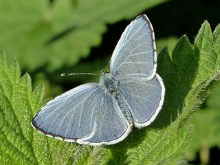
Widespread and common


Distribution and Status
The Holly Blue is widespread and common in our branch area, more so in urban Middlesex. It is absent in some areas in arable north Hertfordshire. Numbers fluctuate widely giving rise to a regular cycle of between four and seven years, believed to be caused by a parasitic ichneumon wasp Listrodiomus nyethemerus although climate is also probably a factor. Numbers bounced back up in 2022 after appearing to be on the downward trend in the last few years
Habitat Requirements
Parks and gardens as well as churchyards, woodland rides and hedgerows. This is the only British butterfly to select different foodplants depending upon the season
Larval Foodplants
Holly Ilex aquifolium in the spring and Ivy Hedera helix in late summer. [Gorse Ulex europaeus, Dogwood Cornus sanguinea, Bramble Rubus fruticosus, Raspberry R. idaeus]
Adult Food Sources
Buddleia Buddleja davidii, Bramble R. fruticosus agg., Veronica Hebe x francisana
Behaviour/Observation notes
Unlike the other 'blues', in some ways the Holly Blue behaves more like a 'hairstreak' as it frequents holly and ivy trees. Owing to its strong flight it can be frustrating to get a close-up view but if females are egg-laying then opportunities for taking a photograph are greater. It often basks with its wings half open in the early morning but later in the day they are usually closed. Males sometimes visit the ground on mud or puddles, and animal droppings

Life History
The Holly Blue produces two generations a year and a partial third brood now appears to be regular with reports coming in for October and November sightings. Eggs are laid singly on unopened flower buds of any number of foodplants in the spring, and ivy in late summer. Larvae feed on the buds leaving holes which is a clue to their presence on neighbouring buds. Larvae leave the foodplant when fully grown to pupate on the ground. Those which pupate from the late summer brood overwinter in this stage
Further information
Photo gallery
Branch Annual Report (2022)
UK distribution map
Full list of larval hostplants (Lycaenidae)
Stevenage butterflies - additional notes